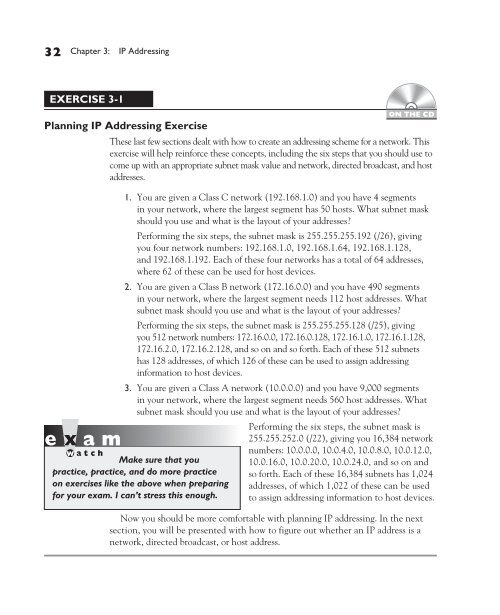ch03 IP Addressing.pdf - The Cisco Learning Network
ch03 IP Addressing.pdf - The Cisco Learning Network
ch03 IP Addressing.pdf - The Cisco Learning Network
You also want an ePaper? Increase the reach of your titles
YUMPU automatically turns print PDFs into web optimized ePapers that Google loves.
32 Chapter 3: <strong>IP</strong> <strong>Addressing</strong><br />
EXERCISE 3-1<br />
Planning <strong>IP</strong> <strong>Addressing</strong> Exercise<br />
ON THE CD<br />
<strong>The</strong>se last few sections dealt with how to create an addressing scheme for a network. This<br />
exercise will help reinforce these concepts, including the six steps that you should use to<br />
come up with an appropriate subnet mask value and network, directed broadcast, and host<br />
addresses.<br />
1. You are given a Class C network (192.168.1.0) and you have 4 segments<br />
in your network, where the largest segment has 50 hosts. What subnet mask<br />
should you use and what is the layout of your addresses?<br />
Performing the six steps, the subnet mask is 255.255.255.192 (/26), giving<br />
you four network numbers: 192.168.1.0, 192.168.1.64, 192.168.1.128,<br />
and 192.168.1.192. Each of these four networks has a total of 64 addresses,<br />
where 62 of these can be used for host devices.<br />
2. You are given a Class B network (172.16.0.0) and you have 490 segments<br />
in your network, where the largest segment needs 112 host addresses. What<br />
subnet mask should you use and what is the layout of your addresses?<br />
Performing the six steps, the subnet mask is 255.255.255.128 (/25), giving<br />
you 512 network numbers: 172.16.0.0, 172.16.0.128, 172.16.1.0, 172.16.1.128,<br />
172.16.2.0, 172.16.2.128, and so on and so forth. Each of these 512 subnets<br />
has 128 addresses, of which 126 of these can be used to assign addressing<br />
information to host devices.<br />
3. You are given a Class A network (10.0.0.0) and you have 9,000 segments<br />
in your network, where the largest segment needs 560 host addresses. What<br />
subnet mask should you use and what is the layout of your addresses?<br />
Make sure that you<br />
practice, practice, and do more practice<br />
on exercises like the above when preparing<br />
for your exam. I can’t stress this enough.<br />
Performing the six steps, the subnet mask is<br />
255.255.252.0 (/22), giving you 16,384 network<br />
numbers: 10.0.0.0, 10.0.4.0, 10.0.8.0, 10.0.12.0,<br />
10.0.16.0, 10.0.20.0, 10.0.24.0, and so on and<br />
so forth. Each of these 16,384 subnets has 1,024<br />
addresses, of which 1,022 of these can be used<br />
to assign addressing information to host devices.<br />
Now you should be more comfortable with planning <strong>IP</strong> addressing. In the next<br />
section, you will be presented with how to figure out whether an <strong>IP</strong> address is a<br />
network, directed broadcast, or host address.

















